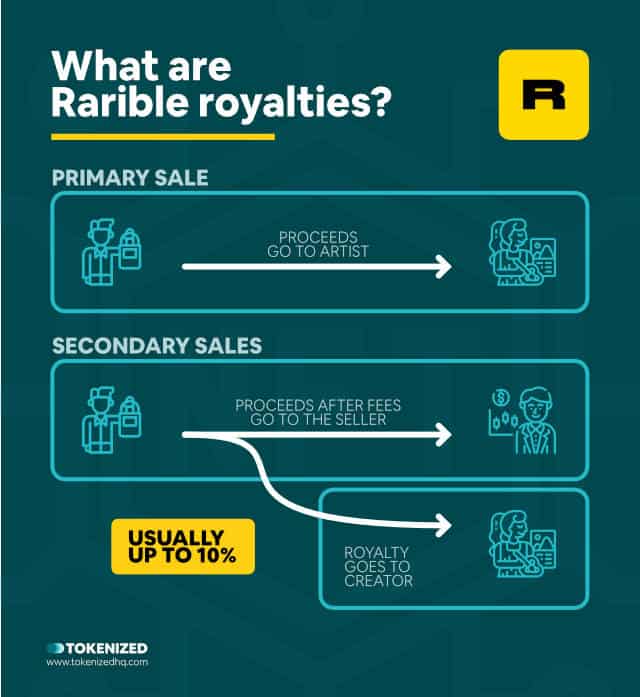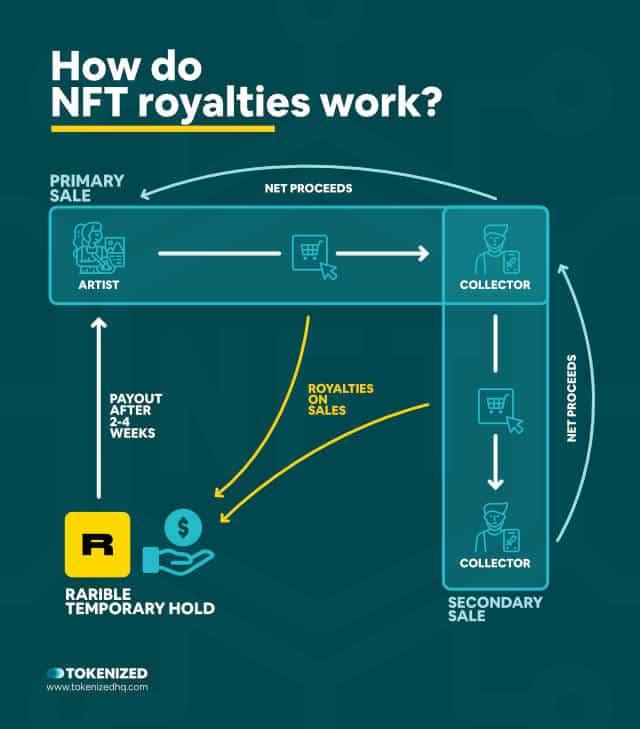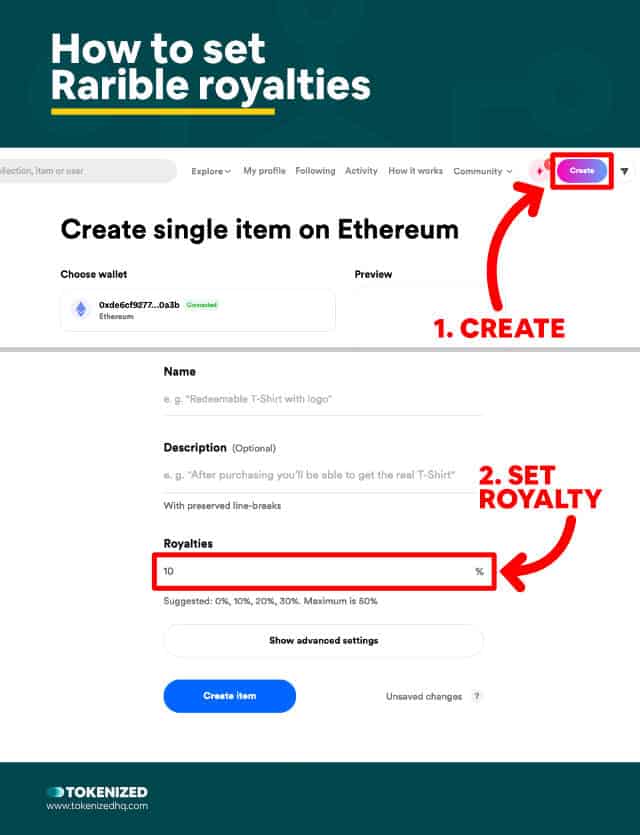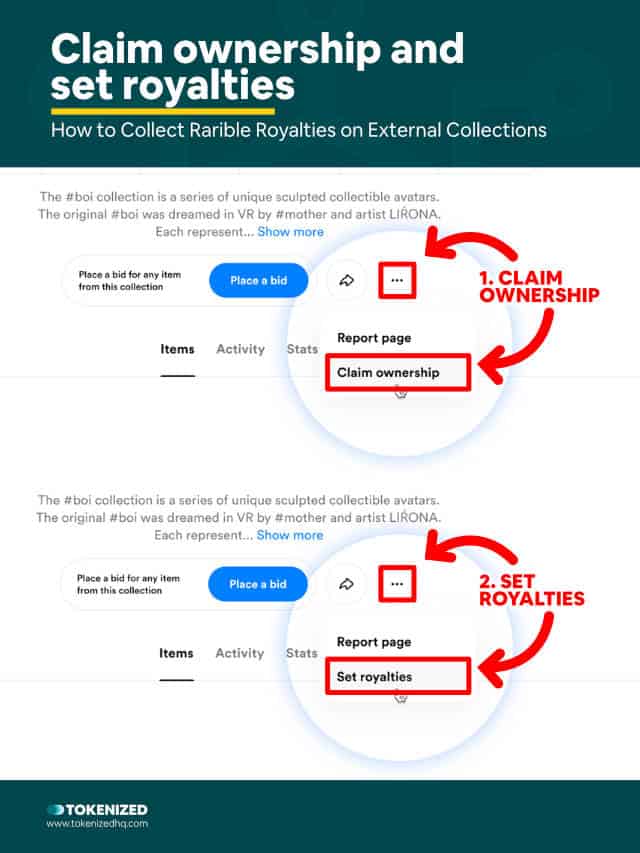Are you trying to understand how Rarible royalties work?
Perhaps you’ve understood the concept of NFT royalties but you’re still not really sure how royalties are automatically enforced?
Don’t worry, because this is a common question and the answer might just surprise you quite a bit.
In this article, you’ll learn how Rarible royalties work, how to set royalties on Rarible as well as how to collect royalties on Rarible even if your collection was created on another platform.
Let’s dive right in.
Key Points (tl;dr)
- Rarible royalties are the same thing as all NFT royalties. They are essentially a commission that is earned by the original NFT creator on all secondary sales of his work.
- On Rarible, you can set the royalty percentage of your NFT when you create a new item or you can also edit it at a later date.
- If you created you NFT collection on another site, royalties will not automatically be collected for transaction on the Rarible marketplace. However, you can claim ownership of your collection on Rarible and then set a royalty there as well.
- If you are creating a custom smart contract for your NFT project, you can implement royalties for many major NFT marketplaces, so that royalties will be collect on your behalf.
For a step-by-step guide on how to collect Rarible royalties from external collection, PLEASE SCROLL FURTHER DOWN THE ARTICLE.
Like this content? Then share it!
Rarible Royalties: Everything You Need to Know in 2023
www.tokenizedhq.com
Here’s the answer. Great article by @ChrisHeidorn right here: https://tokenizedhq.com/rarible-royalties/
What Are Rarible Royalties?
Rarible has its own implementation of NFT royalties and manages them on-chain with the help of a royalty registry contract. This smart contract ensures that royalties are levied on each marketplace transaction and forwarded to the original creator.

Royalties are one of the fundamental aspects of NFTs that make them so compelling for many creators.
By adding a royalty percentage to their NFT collection, creators can make sure that they participate in the future success of their creations.
Every time one of their NFTs is sold on the secondary marketplace, the creator receives a cut of the sales price.
This uniquely aligns incentives of both the creator as well as the collector or investor.
The collector has a vested interest in the success of the creator and is more likely to promote him as a result of this.
On the other hand, the creator also has an incentive to continue to create value for the holders of his token, because it increases the amount of royalties he stands to make.
It’s important to point out that when people talk about “Rarible royalties” they actually mean the creator royalties and how they are handled by the Rarible NFT marketplace.
If you’re keen to know more about how royalties work on the biggest NFT marketplace in the world, we recommend you check out our guide on OpenSea royalties as well.
How Do NFT Royalties Work?
NFT royalties are calculated as a percentage of the sales price for every transaction. The royalty rate usually ranges between 0% and 10%, and it is paid out to the original creator of the NFT after every secondary sale. NFT royalties are currently mostly platform-specific. That means that when a sale takes place on a marketplace other than the one where the NFT was created, royalties are not collected for the creator.

You can think of NFT royalties as a perpetual commission on every purchase and sale of an item you created.
Imagine you created a painting and sold it to a collector.
Years later, when you are famous, the collector auction off your artwork and sells it for 100x the original price he paid to you.
In the traditional art world, you wouldn’t receive a single penny from his sale and everything would stay with the collector.
With NFTs, it’s very different, because smart contracts make sure that you, the original creator, receive your fair share of the sales price.
Whenever someone profits off your work, you get your cut.
The only challenge is that currently, most NFT collections do not implement royalties management at the token or contract level.
That means that while royalties are easily handled as long as the NFT is sold on the same marketplace that you minted it on, this is not necessarily true on external platforms.
The only reason you currently still receive royalties for sales on other marketplaces is that major platforms have put agreements in place that they will honor royalties from each other’s systems.
How to Set Royalties on Rarible
On Rarible, you can set the royalty of your NFT from within the form that you use to create the NFT, right after the Name and Description fields. You can set your royalties on Rarible to anything you like, up to a maximum of 50%.

Unlike on OpenSea, where royalties are set for collections rather than individual NFTs, Rarible royalties can be set for a single NFT as well.
And while OpenSea limits the royalty percentage to a maximum of 10%, Rarible gives you significantly more freedom.
If you wanted to you could set the royalty as high as 50%.
Despite all this extra freedom, we do believe that you should stick to royalties of no more than 10%.
Bear in mind that anything above 10% is guaranteed to come across as quite greedy and will likely negatively impact the success of your project.
How to Collect Rarible Royalties From External Collections
You can collect royalties on Rarible even if you didn’t create your collection there. In order to set up Rarible royalties, find the collection on Rarible, and claim ownership from the options dropdown menu. Once you’ve successfully claimed the collection you can select “Set royalties” from the same options menu again.

If you created your collection on a marketplace other than Rarible, royalties are not automatically collected.
However, you can fix this by claiming ownership of the collection via the Rarible interface and then setting the royalties from there.
Follow these steps to claim your collection and set up its Rarible royalties:
- Step 1: Look for your collection on Rarible
- Step 2: Click the button with 3 little dots and select “Claim ownership”
- Step 3: Now click the 3 little dots again and select “Set royalties”
- Step 4: Set the Rarible royalties you’d like to collect and save
As you can see, it’s incredibly easy to set up Rarible royalties even if you didn’t originally create your collection there.
How to Implement Rarible Royalties in Smart Contracts
While most artist will create their NFTs using the minting tools provided by NFT marketplaces such as Rarible or OpenSea, more advanced and professional NFT projects may want to create custom smart contracts.
Although custom smart contracts for NFT collections provide significantly more flexibility, one of the drawbacks is that royalty collection for various marketplaces is not supported by default.
Therefore you may need to integrate all the different royalty implementations of Rarible, OpenSea, Mintable, and others.
We’re not developers, however, we collected some useful links for your perusal.
Assuming you are a developer, we’re quite confident these sources will be quite useful for you:
- Rarible Royalties on NPM
- Rarible Royalites Contract on GitHub
- Implementation Guide for Secondary Royalties on Rarible
- Developer Tutorial for Rarible Royalties
Conclusion
Contrary to popular opinion, NFT royalties are usually not coded into the smart contract itself.
This means that royalties collected on one platform are not necessarily collected on others.
Many large marketplaces have reciprocal agreements in place and you can also claim your external collection on Rarible.
Nevertheless, NFT project founders may want to consider baking royalty support of different marketplaces straight into their smart contracts.
Here at Tokenized, we want to help you learn as much as possible about the coming NFT revolution. We help you navigate this fascinating new world of non-fungible tokens and show you how you can integrate tokenization into your own business.



